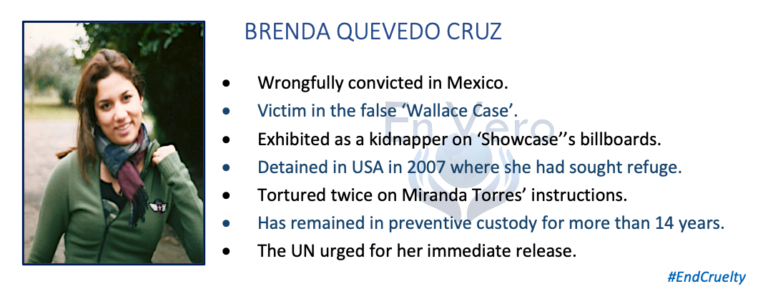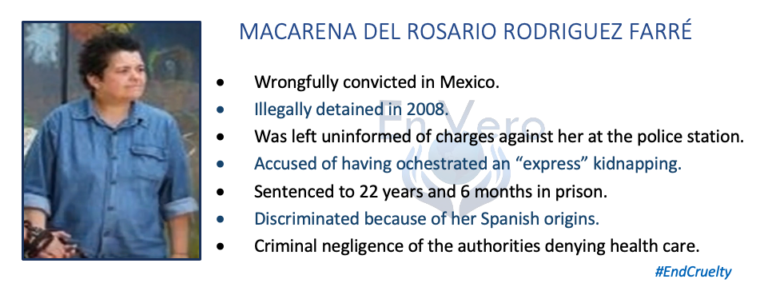The Sordidness Behind the Wallace Case
Source: Proceso (Spanish)
By Jorge Carrasco Araizaga
Official documents and testimonies from the alleged suspects of the kidnapping and murder of Hugo Alberto Wallace Miranda accuse the virtual candidate of the PAN for the governorship of Mexico City, Isabel Miranda de Wallace, to have been involved into criminal activities, torture included, while seeking to resolve her son’s case. The stories of mothers, sisters, even uncles of persons incarcerated for that matter concur with the facts gathered into the legal files. Mrs Wallace is using the power that her “friendship” with the president Calderón and Mexico City ex D.A. Miguel Mancera, grants her…
Barely one day after the disappearance of her son Hugo Alberto, Isabel Miranda de Wallace had already tracked down the place where she claimed her son was killed in a kidnapping attempt. In less than 24 hours she had found his car, found the apartment that she denounced as the place where the events took place; events that ultimately turned her into a public figure. She also had references on two people named as being in charge of the operation.
In the early morning of Tuesday July 12, 2005, Miranda had already denounced the disappearance of Hugo Alberto. She knew that an attractive woman known as Claudia was among the implicated, as well as a local policeman. What’s more, she handed a clue to the country’s Attorney General: They had to find Jacobo Tagle Dobin. She gave them his exact address. According to criminal investigation PGR/SIEDO/UEIS/146/2005, opened on the disappearance of Hugo Alberto Wallace Miranda, thanks to the statement of a nosy neighbor, hearing a boy that was in the building and based on an envelope that was sent by an anonymous person to her home with several emails, she began to reconstruct the circumstances surrounding what happened inside apartment 4 of 6 Perugino Street, South of Mexico City.
In little over two months, she knew the operation and members of the “gang of kidnappers”: Former Morelos policeman César Freyre Morales; dancer Juana Hilda González Lomelí, Claudia; shopkeeper Jacobo Tagle; his girlfriend Brenda Quevedo Cruz, y brothers Alberto and Tony Castillo Cruz.
For half a year the Assistant Attorney General’s Office for Special Investigations on Organized Crime (SIEDO) lacked enough elements to bring them to the authorities. It was not until February 8, 2006 when it could present charges of kidnapping and murder based on an expanded statement of Juana Hilda, in which she allegedly detailed the participation of each member. Such a statement contradicted two previous ones in which she denied all charges. But she has not ratified it because it was taken without legal counseling, outside the place of her arrest and under coercion of members of the attorney general’s office Fermín Ubaldo Cruz and Braulio Robles Zúñiga, according to file number 180/2010 opened by Mexico’s Instituto Federal de la Defensoría Pública del Consejo de la Judicatura Federal.
The members of the ministry threatened to hurt her family, just as they had done with César Freyre’s mother and sister, who were jailed on charges of alleged extortion. According to the file, that statement included a confrontation, unsolicited by Juana Hilda, in which she supposedly asked Isabel Miranda for forgiveness.
Fermín Ubaldo and Braulio Robles are also identified by Enriqueta Cruz Gómez, mother of Brenda Quevedo Cruz: “By mid 2006 I was called to the SIEDO. Braulio introduced me to his boss, Fermín Ubaldo Cruz, who started to talk to me nicely, asking me to tell him exactly where was my daughter,” Enriqueta told Proceso.
Brenda had ran away to the United States. She was hiding when Isabel Miranda placed several billboards -she works in the industry- featuring Brenda’s photograph, accusing her of the kidnapping and disappearance of Hugo Alberto.
Enriqueta Cruz continues: “Obviously I didn’t tell him anything, but the man was growing desperate and began to bang on the table. ‘Speak, damn it!,’ he told her. “Just like you are sitting here, so have the mother and sister of César Freyre and I put them in jail,’ he told her. Enriqueta Cruz asked: “Why did you put them in jail?”. The minister was so desperate that he ordered for a sample of her hair and blood. “What for?” the woman asked. “For when we find your daughter dead, because we are going to find her dead,” he yelled.
Brenda Quevedo
Brenda Quevedo was extradited from the United States in September 2009. She arrived in a plane of The Office of the Mexican Attorney-General (PGR) also carrying Braulio Robles. Miranda was expecting her at the airport with a sign that asked: “What did you do with my son”? Before she was presented to the media, she offered her “legal benefits.” Brenda confronted her. She was moved to the Centro de Readaptación Social in Santiaguito, Almoloya, Estado de México. According to her testimony, narrated in a letter dated November 29th of that year, at about 7 am on Nov. 27th a guardian went to look for her for a supposed hearing. With the approval of the center’s director she was taken to a room.
She says that when she went in she saw three people facing the wall. They wore ski masks. They wore gloves. In desperation, Brenda began to yell. She said she was held by force. “You know who sent us here you bitch!” Crying, she replied: “Yes. It was Isabel Miranda de Wallace.”
“Now you are going to feel the exact same thing Hugo felt the day he was kidnapped,” she says she was told. Immediately, they put a plastic bag over her head, threw her to the floor, kicked her in the stomach, and hit her in the head.
From a small briefcase they took out a set of handcuffs, bandages, syringes, audio recorder, paper and pen and “a little machine that I assumed it was to give me electric shocks,” Brenda wrote. She was blindfolded. She says they pulled her by the hair and put the recorder on her face. One of the men said: “Now, you are going to tell us where Hugo’s body is. You are going to give us an address and we will take you out of this penitentiary. And if you give us false information, we are going to torture you until you are unrecognizable and we are going to go to each member of your family. Your brother is in Canada, right? Brenda says she was sexually assaulted.
According to her letter, they took out a syringe with a red substance. They told her it was HIV-infected blood. That they were going to inject her if she didn’t sign a confession in which she says she was responsible for the kidnapping. They would put a pen in her hand. After a while, after someone came knocking on the door, they packed up their things and left.
One year later, in another letter, dated November 2010, she talks about the torture she was subjected to on October 13th, five days after she was moved to the federal penitentiary of Islas Marías. Under the pretexts that they found some pills in her bed, she was taken to “the drunken one,” a special punishment cell.
Around 3:00 am on the 14th, two guards took her out of her cell and put her in a white pick-up truck driven by a man. Half an hour or 40 minutes into the road, in which she heard and saw the sea, they stopped at a place with lots of vegetation. They descended and left her in a small house under construction.
There was no light. Only an old sheet on the floor. She fell asleep there. Around 1:00 PM, through a window she saw a white Van with tinted windows. The door opened and five or six men wearing hoods walked in, they were wearing white shirts, jeans and black shoes. The first one to come forward asked her: “Now you are really screwed. Remember us? Now nobody will hear you here.”
Always according to her, Brenda was blindfolded and wrapped in the bed sheet with duct tape. They took off her socks and shoes; she was laid down and they started to throw water into her nose and mouth. They asked her if she didn’t feel bad that her mother had to suffer “for her fuckedupdness.” “We were going to kill her the day she was operated in her eyes, or maybe just make her go blind, but then we thought it’s really not her fault.”
With the humidity from the water, the bandage over her eyes moved and she distinguished the light brown eyes of one of her aggressors, she recognized one with a sturdy built and lots of body hair that sometimes would be on top of her.
They continued beating her. She was bleeding. “Now you know why we are here?” She replied: “For the kidnapping of Hugo.” One of them hit her so hard that she was left half deaf and told her: “From Mr. Hugo, to you.” They tied a wire around her right toe and threw more water at her. They were giving her electric shocks.
They took out a recorder. “You have to say that you took Hugo’s body to the apartment in Perugino, that you took out his body in bags and used your car to throw him out there. Say that you took photos of his body.” They would turn the recorder back on when Brenda repeated: “We left him in the aqueduct and several suitcases in a vacant lot.”
One of them told her: “You’d better not get back to that bullshit of human rights. Please realize we have all the power to come all the way to this place. We have a lot of power. You messed with the wrong people. This happens to you for bothering the señora, her husband and her family.”
One of the men told her: “You are going to ask to speak to the judge and you will say you regret everything you have done and that everything that Hilda has said and you are going to apologize to Mrs. Wallace.”
The same custodians that a day before had taken her to the special punishment cell took her there again. She left the next day, but was kept in confinement. It was almost a month before she could use the telephone and tell her mother was had happened.
Alberto and Tony Castillo
On October 12, 2010, a day before the alleged torture of Brenda, it was the turn of Alberto Castillo Cruz, accused, along with his brother Tony, of mutilating the body of Hugo Alberto. It happened at the Puente Grande penitentiary, which along with Islas Marías and other federal penitentiaries are under the charge of the Public Safety Minister Genaro García Luna.
Alberto had been beaten already on March 8, 2006, when he was detained near a Mexican landmark, the Monument to Revolution, very close to the SIEDO– by a couple of men dressed in black and wearing ski masks that accompanied Isabel Miranda.
The account of the alleged tortures on Alberto and the threats to his family members comes from their mother, María Elena Cruz Bustamante, who claims that since that date she was threatened to be killed along with her uncle Luis Carrillo Bustamante, if she didn’t say that he and those pointed by Miranda were behind the disappearance. “You would be better off if you had killed the son of the president. You will fear the power that Mrs. Wallace has.”
They asked him for his brother and his “cousin” Brenda Quevedo Cruz. “She is not my cousin. I have seen her somewhere, but she is not a friend,” replied Alberto, according to María Elena Cruz, who was interviewed by Proceso. “They took out a gun and continued with the threats. Two and a half hours later he was handed to the AFI,” the Federal Investigations office, which was then under García Luna.
On March 22, 2006 Tony was presented to SIEDO. He was arrested there. When Alberto and Tony made a statement before Braulio Robles, they said they were U.S. citizens and worked in Mexico for American companies. “Here you are in Mexico, so here you are fucked,” he told them.
They were arrested and after two months were sent to the Reclusorio Norte (Reno) where they were extorted for being “kidnappers and murderers.” One year and a half before their sentence, and without even telling their family, they were sent to a federal prison. Alberto went to Puente Grande. Tony to Matamoros. They were segregated during nine months.
Since mid 2006, when they were sent to Reno, the telephone threats to their families began. If they were to notify the U.S. embassy, they were going to kill their children inside the prison. To them, they told them the same thing. You know who this is coming from. “Three or four times a woman’s voice called me,” says the mom of the Castillo brothers.
“There were the same threats for years. They were quiet on their side. I was quiet on mine. We were afraid to be killed.” Alberto, who is about to turn 39, was sent to Puente Grande. There, says his mother, on October 12, 2010 he was tortured to sign his culpability. In exchange, he would be a “witness protected by Mrs. Wallace.” “I’d rather die,” he said.
As in Brenda’s case, says Mrs. Cruz, men wearing ski masks were the ones in charge. It was inside a room of Observation and Classification (COC) at Puente Grande. He was handcuffed. He was wrapped in a bed sheet and they began to hit him. To suffocate him they used water and plastic bags.
A man would squeeze his neck with a towel and cover his head with a bag, while another man, a short man, would hit him. To another man he describes as “hairy, sturdy, dark skinned.” It all happened in front of Robles Zúñiga, he told his family.
“You have to say you took part in it. You are going to do that in front of the judge,” he was told. The next day he was taken to the court. There -says Mrs. Cruz- there were Braulio Robles, Isabel Miranda and her brother Roberto, to whom he identified as one of the men who, waving a gun, arrested him in March 2006.
At the hearing Alberto denounced the torture. The following day the exact same thing happened to him. He was put again in the COC. “So, you were extremely stupid yesterday, right?”
María Elena Cruz continues: One of his torturers kept looking towards the door and up the ceiling. That is how he realized that Isabel Miranda and the director of Puente Grande, Francisco Javier Gómez Meza, were watching the torture. One week later, Gómez Meza was fired, accused of drug dealing. To prove this, Alberto requested the videos of the cameras inside the penitentiary. They didn’t give them to him. They said these were erased every 3 days.
Alberto then decided that his family should notify the U.S. Embassy, which has been assisting them since. Also Alberto, first through the U.S. Consulate in Guadalajara and now through the one in Hermosillo, since last year was transferred to Guasave, Sinaloa.
Jacobo Tagle
Two months after the alleged torture of Brenda and Alberto, Jacobo Tagle Dobin was detained in the State of Mexico. He was the last of the six people indicated by Miranda. He was presented to the media on December 4, 2010.
In a letter, dated one day earlier in Cuautitlán Izcalli, he narrates the circumstances of his arrest: men wearing ski masks, dressed in black driving non-police vehicles, handcuffed him and put him inside a white van carrying other men wearing ski masks. His head was covered and after about a 40-minute drive, he estimates, one of the men told a woman. “I have your package. What do you want us to do with it, ma’am?” According to Tagle, the response was: “Torture him until he tells you where my son is.”
The van drove another 15 minutes. When it stopped, he was blindfolded and they took off his socks and shoes. They covered his head with a plastic bag. He felt someone sitting on his lap and another one was squeezing him. He was naked from the waist up; his ankles and arms with bandages. They repeated the operation.
They threw water on his face. He was being suffocated. He heard someone saying: “If you see his nails go purple, let me know.” Again, they covered his nose and mouth, threw water, beat him on the ears, pushed his stomach.
They started the van again. “Now, let’s go to the attorney’s office. You have to admit everything.”
There, “a white-haired man, I think it was the boss, told me that Mrs. Wallace was going to come in and if I didn’t cooperate they would beat the shit out of me again… a short man went in, wearing jeans and a checkered shirt. They took out a gun, prepared it for shooting, and pointed at my head.”
The threats continued. “You’d better cooperate or you will die. I have been looking for you everywhere and you are going to pay. I know exactly where your mother Raquel lives as well as your sister Judith and we have nailed down your brother Salomón.”
Says Jacobo: “The short man left and came back with Mrs. Wallace, her daughter and nephew and two other men. Mrs. Wallace put herself on the other side of the desk and told me I was going to die, that they were going to hurt my family and put my brother (also accused of kidnapping) in jail.”
She asked him to put César Freyre, Hilda, Brenda and the brothers Castillo in jail forever, “because she was a personal friend of President Calderón, of the Attorney General and of Miguel Mancera (Mexico City’s attorney general) and of many more politicians.
They asked him to repeat what they said. He says that her nephew, whom he doesn’t identify by name, recorded his statement while her daughter was typing in a laptop. “They didn’t even let me make a phone call and made me sign all these documents that I didn’t even have a chance to read. We went towards Cuemanco and the señora told me that she was going to show me the place where her son was supposedly abandoned.
“They took me in a van and she was in a Cherokee, with a lot of escorts and a policeman. In Cuemanco I was moved to the Cherokee and Mrs. Wallace told me: “We are going to stop and you are going to walk. Where you see the entrance of a house, you say that it is there. You will go in and you will see to piles of sand and you will say that that was where you dumped my son’s body.”
“From there I went to the attorney’s office and in the morning I was taken to Toluca.” There on December 4 he was presented to the media. At that time, Isabel Miranda asked him to pull up his shirt to show that he had not been beaten up.
In his statement of December 14 of that year at a high security prison in Nayarit, he ratified that he had been tortured.
In that statement it is also found that Jacobo Table “also wishes to add that Mrs. Isabel Miranda made it very clear that he shouldn’t try to be against her or refuse to declare anything because very soon she would have a job in politics and even more power enough to finish up his entire family.”
Tagle, 32, is imprisoned since last October in a high security prison at Villa aldama, in Perote, Veracruz.
César Freyre
César Freyre Morales, a former policeman from the state of Morelos and identified by Miranda as the gang’s ringleader, was also tortured to plead guilty, says his mother María Rosa Morales Ibarra, who was imprisoned and charged with extortion by Luis Saucedo, to whom she identifies as driver and assistant of Miranda.
She spent one year and a half in jail, along with her daughter Julieta, who was accused by Saucedo. They were detained June 8, 2006 when they went to SIEDO to see Freyre, who had been detained three months earlier. Morales says that the then head of the Subprocuraduría, José Luis Santiago Vasconcelos, would pressure her to tell them the location of the safety houses and bank accounts of her son.
The three were arrested. César was transferred to La Palma, and the women went to Santa Martha. There they spend one year and nine months without ever proving the charges against them. They were freed on bail when their crime was reclassified and no longer deemed a federal crime. Julieta, 40, died October 2, 2009 from a brain hemorrhage upon leaving prison.
Says Morales: “After five years, he had to sign a statement. He was pressured hard. They almost killed him. They just extirpated a few blood clots he had as a result of being put many times inside water bags. One of his testicles became smaller as a result of the electric shocks he received. But they insist in handing them the body.” Freyre answers: “How am I going to hand them something that I don’t even know it exists?




